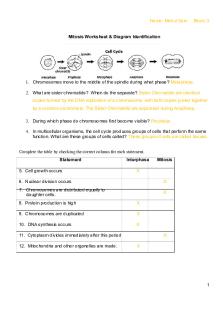Biology 3.01 Mitosis PDF

| Title | Biology 3.01 Mitosis |
|---|---|
| Author | Ali Salman |
| Course | Principles of Biology |
| Institution | Miami Dade College |
| Pages | 3 |
| File Size | 128.5 KB |
| File Type | |
| Total Downloads | 91 |
| Total Views | 152 |
Summary
Download Biology 3.01 Mitosis PDF
Description
03.01 Cell Cycle Lab Report
_____________________________________________________________________________________________ Safety Notes: Always handle microscopes and glass slides carefully. Wash your hands after handling the prepared specimens.
Materials: Compound light microscope Glass microscope slide with prepared onion root tip specimen Purpose: Understand and identify the stages of the cell cycle and mitosis. Apply an analytical technique to estimate the relative length of each stage of the cell cycle. Hypothesis: What do you predict you will find about the number of cells in each of the phases of the cell cycle? Provide an explanation for your prediction.
I believe that there will be many interphase cells, and that that they’ll decrease over time since there will be less and less time. I also believe that there will be many prophase cells as well. Procedure: Data and Observations: Create a data table containing a tally of the number of cells observed in each of the following stages:
Stage
Number of Cells in Number of Cells in Part 1 Part 2
Interphase
34
49
Prophase
8
13
Metaphase
3
4
Anaphase
2
3
Telophase
2
4
Cytokinesis
1
3
Record any observations about the cells you observed (what does the cell look like for each stage): _________________________________________________________________________________________
Data Analysis: Calculate the percentage of the cell cycle spent in each stage. Number of cells in given stage ÷ total number of cells counted × 100 = % of the cell cycle spent in this stage Part 1 Interphase – 68% Prophase – 16% Metaphase – 6% Anaphase – 4% Telophase – 4% Cytokinesis – 2% Part 2 Interphase – 64.47% Prophase – 17.1% Metaphase – 5.3% Anaphase – 4% Telophase – 5.3% Cytokinesis – 4% _____________________________________________________________________________________________ Conclusion:
1) Based on your data, what can you infer about the length of time spent in each stage of the cell cycle? The length of time spent during Interphase would be the longest. The time will eventually keep decreasing until the cycle finishes. 2) What stages were the longest and shortest? Give a brief explanation of why these stages may have that time period. The stage which was the longest would be the Interphase stage, because that is when the cell starts off and develops. The stage which was the shortest would be Anaphase, because the chromosomes are split in this stage, which doesn’t really take that much time. 3) What is a distinguishing visible feature of each stage of the cell cycle? Distinguishing visible features between each stages of the cell cycle are the following: For the Interphase stage, the nucleus is basically showing us a bowl of noodles (picture in lesson). For the Prophase stage, it’s different because the cells are all different and look like an X. As for metaphase, there is only one row instead where there is an X. Anaphase is different because there are two rows at the ends of the cell, and the chromatins are shaped like V’s. Telophase is different because the V chromatins are being separated into two separate nuclei. Cytokinesis is different because the two nuclei are fully separate and are two separate cells. 4) What differences can you see when you compare the nucleus of a dividing cell with that of a nondividing cell? One of the differences are that between the Cytokinesis stage and the Telophase stage, is that during the Cytokinesis stage, both nuclei are separated by a cell wall.
5) If your observation had not been restricted to the tip of the onion root, how would the results be different? The results would have been different because there would be more cells, and hence more stages. We would probably see more cells from the last few stages, and even more interphase cells. _____________________________________________________________________________________________...
Similar Free PDFs

Biology 3.01 Mitosis
- 3 Pages

Mitosis
- 14 Pages

200-301 - 200-301
- 6 Pages

301 2017 4 b - 301
- 24 Pages

301 301 749 Jhon Giraldo Tarea 2
- 18 Pages

Modeling Mitosis & Meiosis
- 12 Pages

Mitosis worksheet-2019
- 3 Pages

mitosis graphs - on excel
- 1 Pages
Popular Institutions
- Tinajero National High School - Annex
- Politeknik Caltex Riau
- Yokohama City University
- SGT University
- University of Al-Qadisiyah
- Divine Word College of Vigan
- Techniek College Rotterdam
- Universidade de Santiago
- Universiti Teknologi MARA Cawangan Johor Kampus Pasir Gudang
- Poltekkes Kemenkes Yogyakarta
- Baguio City National High School
- Colegio san marcos
- preparatoria uno
- Centro de Bachillerato Tecnológico Industrial y de Servicios No. 107
- Dalian Maritime University
- Quang Trung Secondary School
- Colegio Tecnológico en Informática
- Corporación Regional de Educación Superior
- Grupo CEDVA
- Dar Al Uloom University
- Centro de Estudios Preuniversitarios de la Universidad Nacional de Ingeniería
- 上智大学
- Aakash International School, Nuna Majara
- San Felipe Neri Catholic School
- Kang Chiao International School - New Taipei City
- Misamis Occidental National High School
- Institución Educativa Escuela Normal Juan Ladrilleros
- Kolehiyo ng Pantukan
- Batanes State College
- Instituto Continental
- Sekolah Menengah Kejuruan Kesehatan Kaltara (Tarakan)
- Colegio de La Inmaculada Concepcion - Cebu







